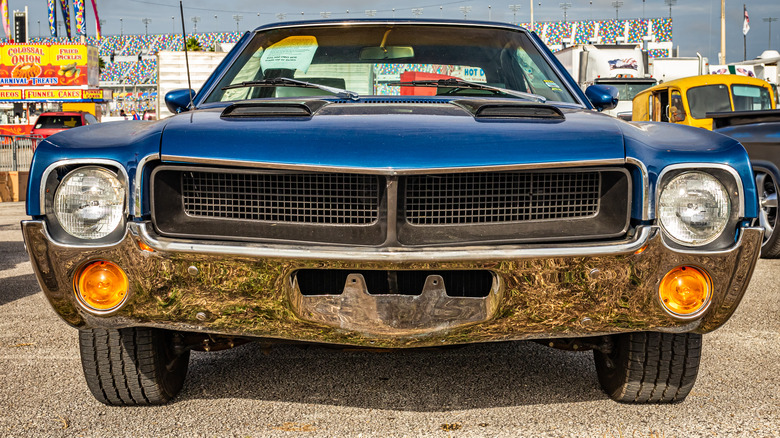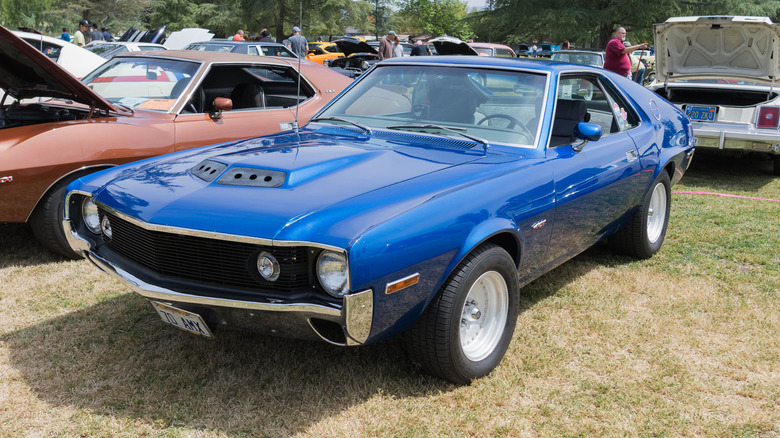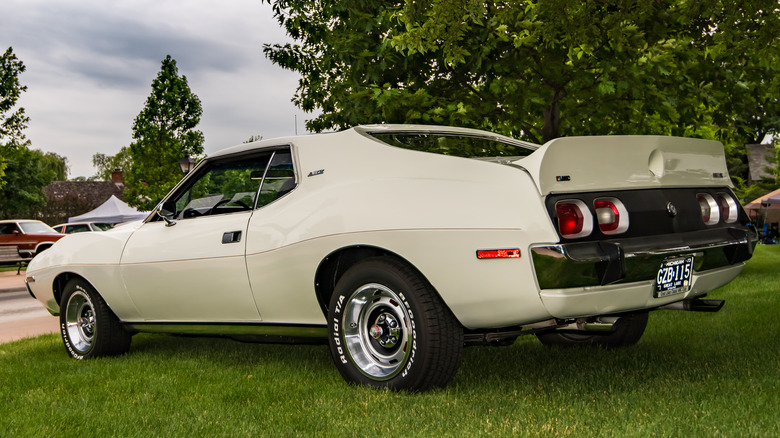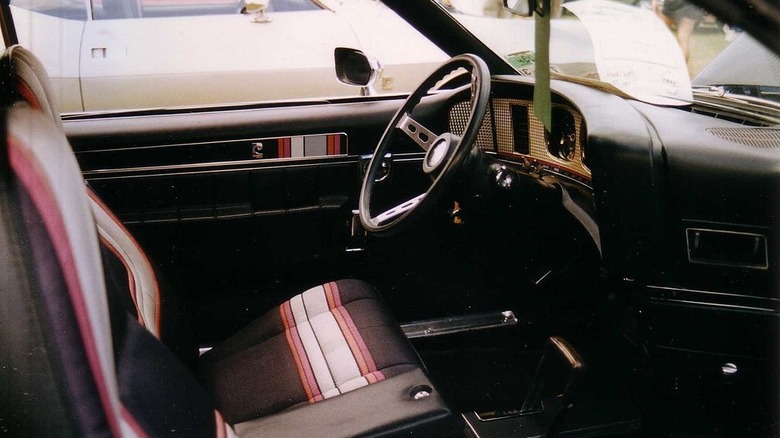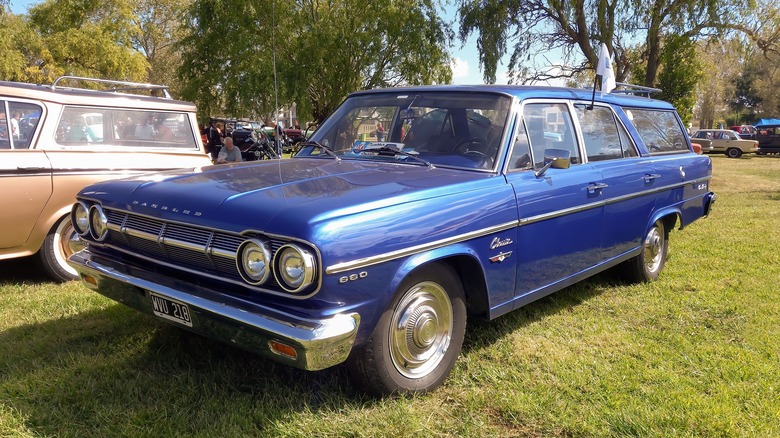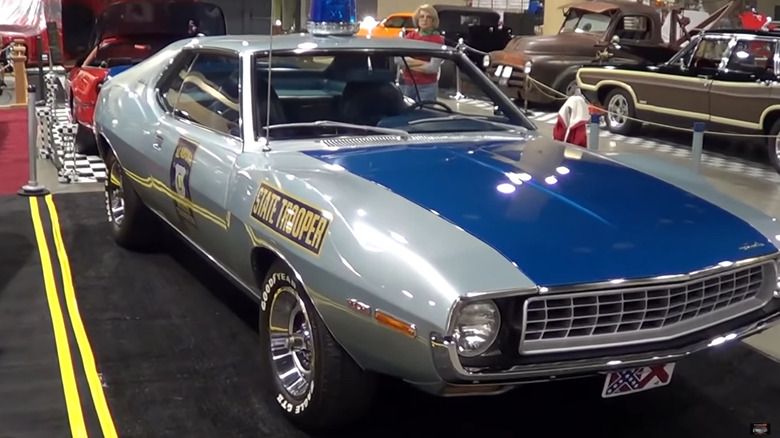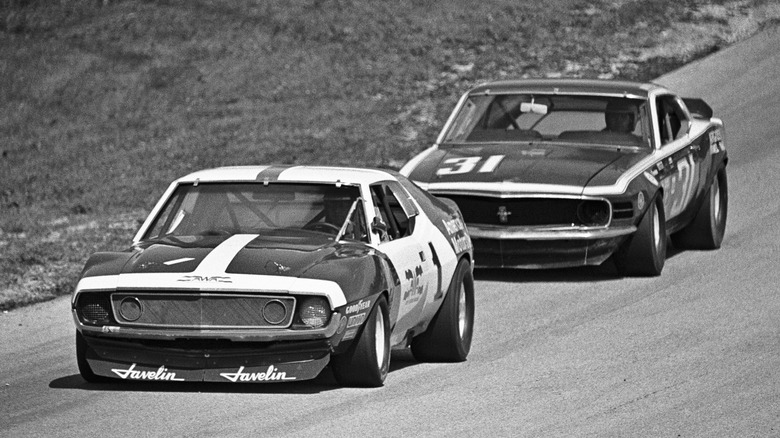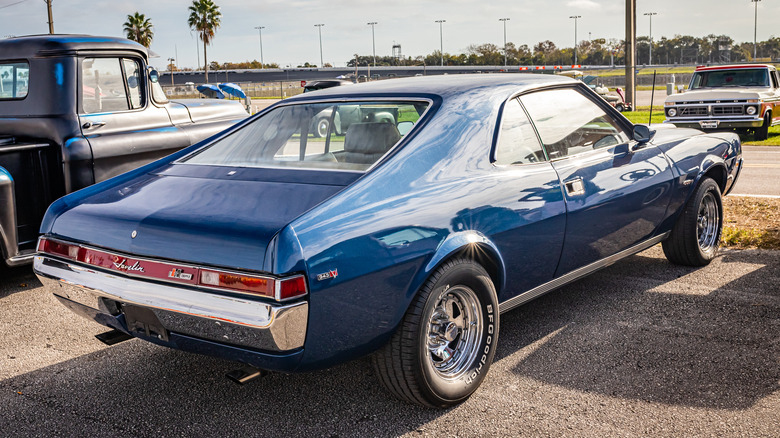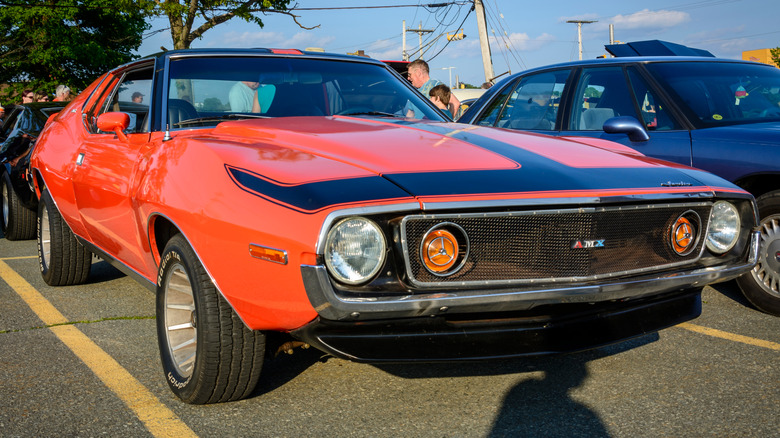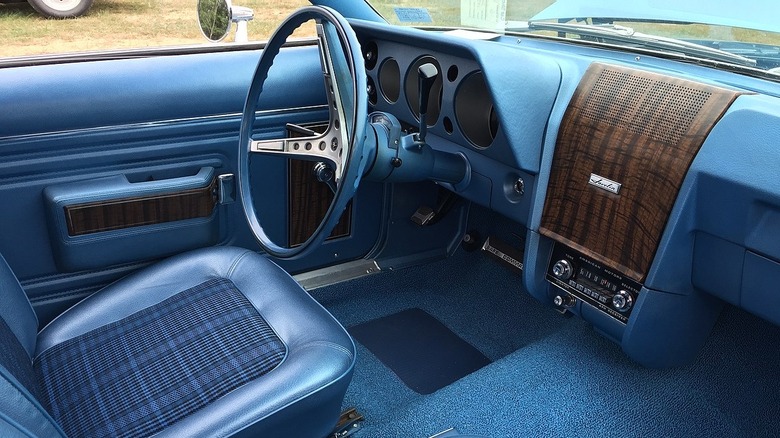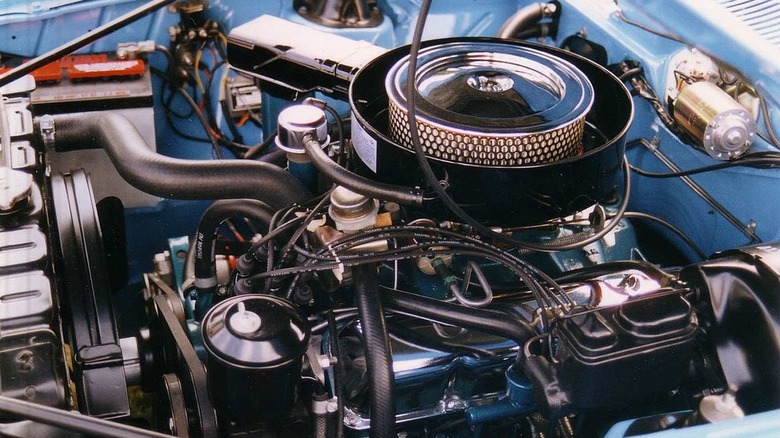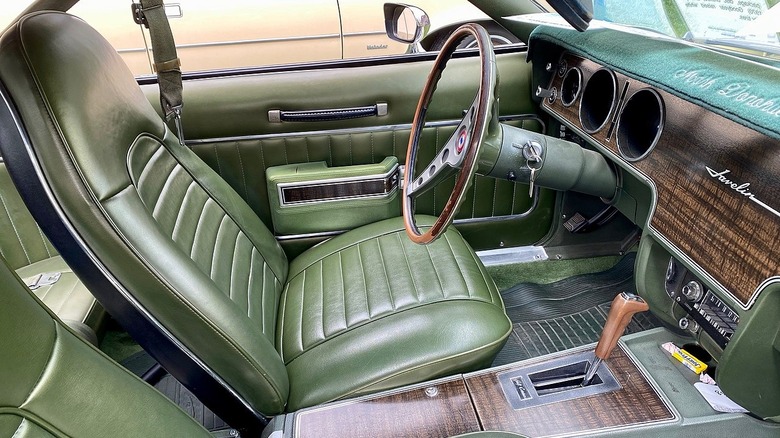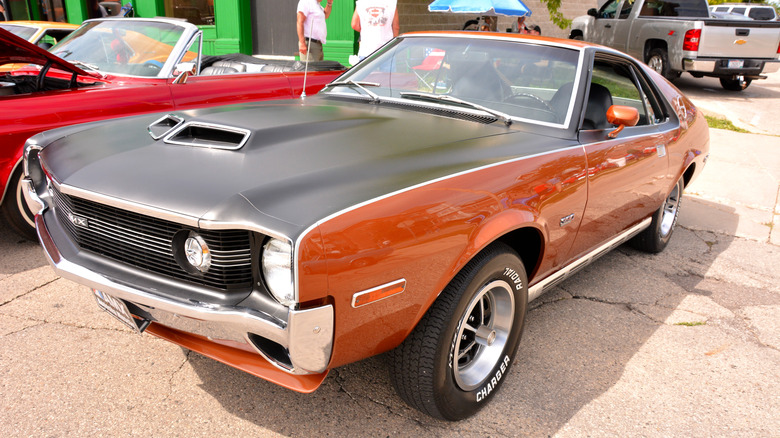12 Facts About The AMC Javelin Only Hardcore Car Fans Know
American Motors Corporation has been shuttered for a few decades but is still beloved by countless fans of its often quirky and unique automobiles. Since its inception as a result of the largest corporate merger in U.S. history at the time, independent AMC struggled to survive as a tiny fish in a very large pond, competing with the largest automakers in the world. Creating unique cars to fill niche markets and utilizing savvy marketing strategies helped AMC to survive as long as it did. As a result, we have multiple models today to stand as a legacy of what AMC was. Among those interesting models is the Javelin.
Produced from 1968 to 1974, the Javelin is a four-seater pony car that sold in a competitive market against the Ford Mustang, Chevy Camaro, and Dodge Challenger. While it would never come close to outpacing its rivals in sales volume, it performed valiantly among other benchmarks, such as styling and performance. Javelins came in two generations with the second iteration coming with the 1970 model year, introducing a new grille, longer hood, and updated lighting front and rear. Javelins were popular on the street and brought AMC into the market alongside its competition, being its first performance-oriented car. Low production numbers mean they are not common today, which means the following 12 facts are those only hardcore fans will know.
Javelin was AMC's answer to the Ford Mustang
The Ford Mustang was a sensation when it went on sale in 1964 and sent other automakers scrambling to create cars to compete with it. While AMC did not traditionally compete head-on with the "Big Three" from Detroit, the popularity of the new pony car segment opened an opportunity for AMC to expand its offerings. The direction toward building a new performance-oriented car came from a new investor in the company, Robert Beverly Evans, according to Attic Capital. Wanting to change AMC's reputation for making mostly staid family cars, he suggested a pony car would raise the image toward a youthful and energetic audience.
In 1966, a concept was shown at the Society of Automotive Engineers called the AMX concept. This concept spawned both the Javelin and AMX production vehicles, per Heacock Classic. Response to the concept was enthusiastic and helped convince the company the time was right for AMC to build the car. However, AMC had just released the Marlin, a two-door fastback, but sales were disappointing — meaning they had to get the Javelin right the first time. The Javelin proved to be a popular model and was praised for its value compared to the competition, offering good performance and ample room for a lower price, prompting sales of up to 56,000 units by the second year. While these production figures were good for AMC, the Mustang still outsold it by a factor of 10.
Javelin set a speed record
In the late '60s, building a performance car and successfully promoting it required some kind of involvement in motor racing. AMC dove head first into motorsports with its new sports cars and sponsored three teams to enter a Javelin in the Bonneville Speed Spectacular, an event held at the Bonneville Salt Flats in Utah. It was a clever publicity stunt to boost the image of the car and received widespread coverage in the media. AMC also enlisted the help of Craig Breedlove, who was well known for having set multiple speed records. The goal of this event was to tie the new Javelin to a famous speed record holder and the Bonneville Salt Flats (via Silodrome).
The competition, co-sponsored by Car Craft, sought applicants through the magazine who would modify the cars for a speed run at Bonneville. Nine participants were chosen and split into three teams to make changes to the three brand-new cars to the best of their ability, using equipment such as an Edelbrock intake manifold with twin four-barrel carburetors. All three Javelins were then gathered at Bonneville and speed runs were performed by Breedlove. The car with the highest speed determined the winning team. Team #2 won the competition and the Javelin set a speed record for C-Production class cars and held onto the record for years afterward. The members of the winning team were each given one of the cars after the competition ended.
Javelins came with designer flair
Special edition cars from big-name fashion designers became popular options in the '70s. AMC created many unique cars during this period, using fashion designers to leave their mark on the auto industry with some pretty outlandish creations, such as the Levi's Gremlin. Throughout the '60s and '70s, one of the most prominent names in fashion was Pierre Cardin, a French designer whose name became one of the biggest names in the industry. His work was near the top in the early '70s, and that is when AMC sought the famous designer to breathe a little style on the Javelin.
While some designer collaborations with automakers at the time could end with bizarre results, the Pierre Cardin Javelin is tasteful and attractive. According to Autoblog, Javelins were available with this $85 option for the last two years of Javelin production, 1972 and 1973. The Pierre Cardin treatment included vinyl seats with thick curving lines of silver, white, and purple in a black interior. Exterior paint colors specific to the package could be chosen among Trans Am Red, Stardust Silver, Snow White, and Wild Plum. This package was offered only on the Javelin SST. creating an elegant and fashionable car with excellent power.
[Featured image by via CZmarlin Wikimedia Commons | Cropped and scaled | CC BY 2.0]
It has economy car roots
Being an independent carmaker without a broad corporate structure meant working on tight budgets for product development for AMC. This also meant that developing a new car in a previously unserved market category was a difficult task. The best way for the company to introduce new models was to reuse and share as much technology as possible. For the Javelin, the best way to bring it to market was to use an existing platform. The best fit for this car was the popular Rambler American compact car chassis.
The third-generation Rambler, which arrived in 1964, was the epitome of basic transportation of the era. AMC had previously built a reputation for building solid cars at an affordable price point but was losing its already small market share fast. According to curbside classic, sales had declined from 164,000 units in 1963 to 63,000 in 1967. AMC first released the Rambler Rogue, a V8 version of the car meant to serve as the small performance car to compete with the Mustang, but only as a temporary measure. It then used that platform for the AMX concept and developed it into both the Javelin and the AMX on a shortened wheelbase, per Hemmings.
The first police pony car
The idea by auto manufacturers to outfit base model cars with high-performance options to use as police cars gained traction in the '60s until it became a common part of the business. In the '80s, Ford developed a package to offer law enforcement a high-performance Mustang for highway patrol duties. These were base-model Mustangs with engine, suspension, and brake upgrades from the GT model. It seemed a novel idea to many people at the time, however, it had been done before.
Like all the other major automakers, AMC offered police packages of its Rambler Classic and AMC Ambassador sedans. Much like AMC, budget constraints with the State of Alabama found officials looking for an economical way to supply troopers with cars fast enough to patrol as it could not afford a fleet of full-size Fords. According to Hemmings, a shrewd Alabama dealer friendly with the director of the ADPS suggested AMC to fill the orders. After receiving a 1971 Javelin SST and a Javelin AMX for testing purposes, Alabam put in an order for a fleet of Javelins equipped with 401 V8 engines with upgraded brakes and suspension. In all, 133 Javelins made it into service in Alabama in 1971 and 1972. While initial reception was positive, troopers eventually discovered deficiencies, such as a tendency to lose traction on gravel roads, that led to future orders for typical full-size cars only, thus ending the Javelin's patrol duties.
The Javelin was a true racing machine
After building sensible cars on a budget, AMC was in no position to put its new performance cars on the track to go up against the established professionals, but it did it anyway. In a tale that would be a true underdog story, AMC lured one of racing's biggest names away from Chevrolet to drive Javelins, Roger Penske. Penske had retired from racing as a driver years before but he continued to manage a successful team. At some point, he had felt slighted by his corporate sponsor, Chevrolet, and decided to join AMC despite being the owner of a Chevrolet dealership (via Motor Trend).
AMC's fledgling racing program fielded Javelins in the Trans Am racing series, placing at the top in more races than the competition, but never taking first place. AMC engineers made several modifications to the cars for the 1969 season, again placing them toward the head of the pack. In 1970 the stars aligned for AMC when Penske was persuaded to join the team with his drivers and race for the company in the 1970 season. More improvements were made to the cars with the new management team in place and updated Javelins were prepared for the 1970 racing season. Penske was so confident in the car, he structured his contract payments based on his confidence in the car winning seven of 12 races. Penske would fall short of his goal but still won three races with the Javelin.
Designed by a legend
For a company disadvantaged by having smaller budgets and smaller networks, it is good to have a secret weapon. For AMC, that was head designer Dick Teague. Some people do great work when blessed with nearly unlimited resources and free reign to create while others do well when tightly constrained and forced to make something from nothing. Teague was the latter, shining at AMC by coming up with workable designs that took advantage of the automaker's budgetary and resource constraints (via Hemmings). Under his direction, AMC came up with several classic designs including the Gremlin, Hornet, Jeep Cherokee, and, of course, the Javelin and its cousin, the AMX.
Teague had penned the somewhat divisive Marlin for 1965 and it fared poorly in showrooms, so AMC needed a win for its first true pony car. New AMC chairman Robert B. Evans decided AMC needed to refresh its image and come up with more exciting cars to drive sales. With this idea in mind, he pressed Teague to come up with a new concept to that end. The result was the attractive and highly styled AMX concept, which was presented to the public as a non-running mockup, but featured such stunning styling it was well received (via Story Cars). While the concept featured styling that would be a bit too radical for regular production, many design elements from this car filtered down into what became the Javelin and AMX production cars.
Javelins around the world
While the Detroit automakers had established international manufacturing organizations long ago in the '20s and '30s, AMC was still a small company with limited resources. Even with its smaller size, AMC ventured into foreign markets and set up assembly in several nationals, mostly assembling knock-down kits, also known as complete knock-down (CKD), from imported parts. Exporting parts for others to assemble cars from CKDs is one of the fastest and easiest ways to establish a foreign presence.
Information on the company can be spotty, though it appears that AMC produced cars in Germany, the Philippines, Mexico, Venezuela, and Australia (via Hot Cars). According to Hemmings, Australian Motor Industries assembled AMC cars branded as Ramblers, even after the name was retired in the U.S. in 1969. Javelins were among those manufactured in right-hand drive, even down under. Karmann, the German coachbuilder that worked closely with VW and Porsche, also manufactured Javelins for the West German market. German AMC enthusiast site American-Motors.de states that Karmann produced just 281 Javelins in Europe, all of which were the SST model, and all but three had automatic transmissions. Hemmings also notes that Mexico was an important market for AMC, producing a full line of cars in Mexico City until the Renault takeover in the early '80s.
What killed the Javelin
While the Javelin showed up as a response to the Ford Mustang and the popularity of the pony car, it would not last through the tumultuous 1970s era of auto manufacturing. The two-seater AMC only lasted two years and left the Javelin as AMC's sole performance car. Javelins sold reasonably well for AMC and the AMC racing program helped bolster their image. Furthermore, AMC created Group 19, according to Motor Trend, to develop high-performance parts to be sold with factory part numbers at dealerships to further enhance profits and prestige for its most powerful models. By most accounts, it was a competent competitor to the Mustangs and Challengers of the day.
The Javelin enjoyed a four-year run, selling more than 100,000 copies in that period. The cars were attractive and came with optional V8 engines producing lots of power and ample torque, but dark clouds gathered on the horizon around 1972. Upcoming federal emissions and safety regulations meant automakers needed to make substantial changes in engineering and design, adhering to increasingly stricter guidelines to pass inspection. AMC had limited resources and had to make a decision on continuing investment into the Javelin to bring it up to par or refocus efforts on the affordable;e and practical transportation for which it had been known for years (via Driving Line). AMC chose the latter and the Javelin ended in 1974.
[Featured image by CZmartin via Wikimedia Commons | Cropped and scaled | CC BY-SA 4.0]
Group 19 offered cheap power
AMC created the aforementioned Group 19 to offer accessories for its cars, Motor Trend notes. Part of this project was meant to integrate performance parts into the company with factory part numbers so that they could be used in stock car racing with strict rules on what aftermarket parts can be used. Generally, parts with an official part number would be fair game, no matter who manufactured it. Therefore, AMC enlisted the help of companies such as Edelbrock and American Racing to develop a line of parts that could be ordered through dealer parts counters.
Among the items one could purchase for a Javelin are an Edelbrock R4B intake manifold, camshaft kit, Holley 780 carburetor, Mallory ignition, Thorley headers, and more. The variety of bolt-on performance parts is impressive and indicative of the horsepower war that was going on at the time. Stock car racing then still meant cars that were stock from the factory and weekend racing was far less technologically involved than it is today. Javelins outfitted with all of the Group 19 mods could potentially achieve 12-second quarter-mile times with the right tires.
[Featured image by CZmartin via Wikimedia Commons | Cropped and scaled | CC BY-SA 4.0]
Javelins are affordable classics
Ultra-rare cars are now hitting marks well into the millions, while rare American classics go for hundreds of thousands with multiple bidders. No part of buying, collecting, or owning classic cars is cheap. But it does not have to break the bank. To own a rare special edition Javelin requires a much smaller investment than a Shelby GT350 or convertible 'Cuda, and, with the lower price, comes the ability to drive the car without fear of losing the equivalent of a lifetime's salary.
Looking through recently sold listings on Classic.com, one can find the most expensive Javelin, a rare Mark Donohue edition with low miles, sold in 2022 for $60,000. Prices drop sharply from there with mint and restored SST Javelins topping out at $40,000. One lucky Bring a Trailer buyer picked up an absolutely perfect Javelin SST with a 390 V8 full of high-performance parts for less than the price of a new Honda Civic. These cars may not be the highly coveted collector cars that fill the garages of millionaires, but can be a genuine source of fun and pride for more down-to-earth enthusiasts who want a car to drive.
Part of a historic auction event
While Javelins can be found in classic car auctions regularly, one such sale in May 2022 was rather historic and it included some precious Javelins. As part of Mecum's Indy 2022 event, a lot of 17 AMC vehicles went under the hammer. According to Car Scoops, the auction included some rare gems from AMC history including a pair of 1969 Hurst SC/Ramblers, a Gremlin super stock race car, and a 1970 Rebel. Other models were more ordinary Pacers and Gremlins with a couple of Jeep Wagoneers for good measure. The collection appears to come from a devoted AMC fan.
While this collection of AMC cars represents some well-preserved examples of the later AMC models, the star of the show was the one-of-three Bonneville Javelins. This is the car that set the 161.733 mph speed record with Craig Breedlove behind the wheel at the Bonneville Speed Spectacular. It remained in pristine condition as it was the day it set the record. The cars were brand new before being modified for the event, and this example showed a mere 22 miles on the odometer. 19 miles were put on the car at Bonneville. The entire incredible spread of cars can be seen on the Mecum website.
